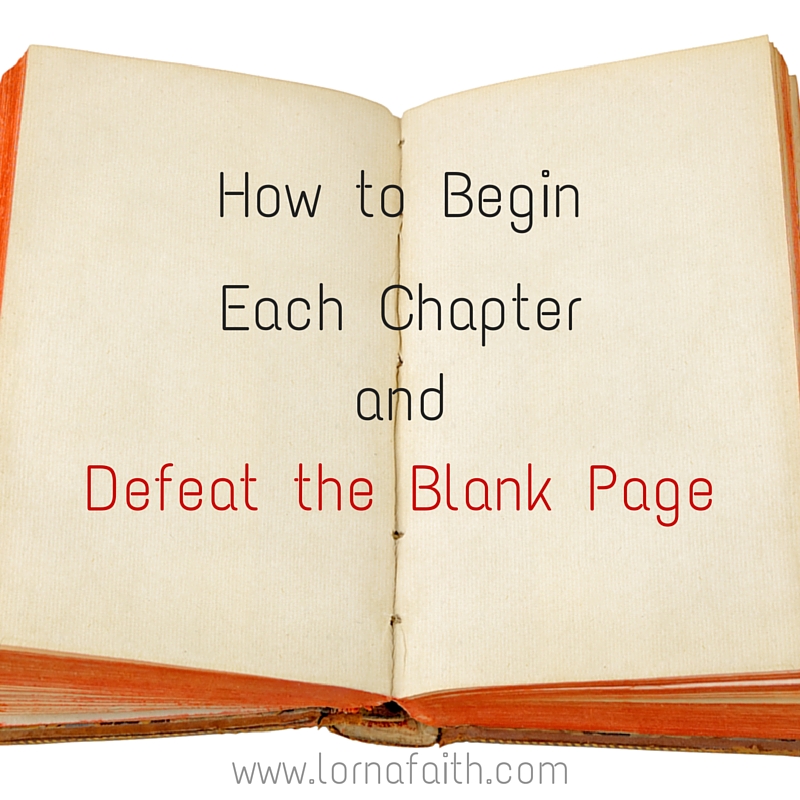Writing a good beginning for each chapter in your novel is tricky.
Sometimes staring at the blank screen(or blank page), is so intimidating we procrastinate.
I know many times looking at the white space on the screen in front of me, has flustered and overwhelmed me to the point that I’ve chosen to do the laundry, vacuum or basically anything else to AVOID that dreaded beginning.
So what helps you begin each chapter and defeat the blank page?

*Photo created with Canva
What are some ideas to help you conquer the blank page?
Many times as writers, our instinct is to add filler to fill in all the gaps between chapters. Sometimes we do this in nonfiction as well as fiction. So we do our best to get every possible detail we can think of, onto the page.
In fiction, we add filler especially when a bunch of time has passed between from the last chapter to the one we’re writing. Many times we add ‘filler’ when there’s a significant passage of time from one chapter to another and we need to catch reader’s up to speed.
I often catch myself adding extra words or phrases when I begin a new chapter. This is what I’m trying to fix as I’m editing my new book right now 🙂
What are some great ways to get started on the next chapter?
Action: When you start a chapter with action – using verbs – can jumpstart your story instead of just using ordinary words… like turn her head, whirl, walk… write words that are more distinctive. Do what you can to avoid those annoying adverbs like walked slowly or walked lazily. Instead substitute words like strolled or sashayed.
As you get your character moving and keep her or him in motion for a page or two you’ll begin to get more ideas on where your next chapters will take you.
Dialogue: Open a chapter with Dialogue. It’s a great way to grab the reader’s attention. When you’re in doubt about how to get a new chapter started, start with a little bit of dialogue.
In Jane Austen’s well-known novel, Pride and Prejudice she starts off one of her chapters with a dialogue between Elizabeth’s parents. “I hope, my dear,’ said Mr. Bennet to his wife, as they were at breakfast the next morning, ‘that you have ordered a good dinner to-day, because I have reason to expect an addition to our family party.”
Conversation draws me into the story – whether it’s fiction or non-fiction.
Sensory Details: Picture where your main character is – like a movie in your mind. Close your eyes and put yourself there and imagine all the details your character might hear, touch, taste, smell or see. Then focus and find an interesting detail, so you can start writing at that point.
The important part to this is that you get started. If you write with too much description, or if you’re not happy in any way, then you can always fix it later.
What are some not-so-good ways to start a chapter?
Backstory: When you begin a chapter with long explanations of a character’s history, it’s not very exciting for the reader. Sometimes that’s a good excuse for the reader to skim. Reader’s don’t need to know about Bobby’s aunt’s puppy and how that little dog peed all over the stairs which caused Bobby to fall down the stairs and break her leg.
It’s much more interesting for the reader if you Show vs. telling what happens to her. Rule of thumb: reading about past action is boring. Current action is what’s exciting to readers.
In a dream or waking up: This has been overdone. If you start the chapter with your character waking up or in a dream, it’s usually isn’t very interesting… and many times this is another place where a reader will skim. Go back and reread a book where the character awoke from a dream and ask yourself did you find it interesting?
Dull vocabulary: If there’s ever a place for brilliance of voice, phrasing, interesting vocabulary, it’s the opening of a chapter. It’s here that you want to catch a reader’s attention. No, you don’t want it so overblown that it is out of character with the rest of the story; however, you do want it to catch the reader. And, the beauty is that if you do overwrite, it’s just a first draft.
These are ideas to help you get something-anything-on paper. There’s plenty of time for revision. But that first draft has to get written, on chapter at a time. So let’s do this thing – you and I both – let’s stop procrastinating… and just write.
How do you begin your chapters to make your story interesting? I’d love to hear your thoughts in the comments. We can learn from each other 🙂
*Photo created with Canva
*Some of the above links are affiliate links that help to support this blog
